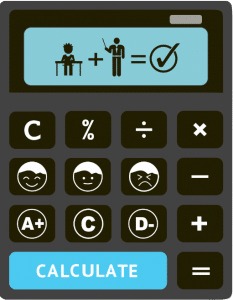Overview
In year 4, you have already learnt about collecting, representing and interpreting data, as well as the basics of Probability (likely and unlikely events, etc.). In year 5 maths, you will dig deeper into these concepts. Let’s start!
Learning Outcomes
In this article, you will learn about
- Ordinal, categorical and numerical data
- The mode of a dataset
- Displaying and reading data on a Line Graph
- Calculating basic probability
Common Types of Data
In Statistics, we collect, record and analyze data. Data can be of different types. Although this is not a comprehensive list, the following are some of the common types of data you will come across.
Ordinal data is a type of data that we use to order or rank things.
Imagine we have a race with three runners – Alice, Bob, and Charlie. We can assign them numbers based on the order they finish the race. So if Alice comes in first, Bob comes in second, and Charlie comes in third, we can say that Alice has a rank of 1, Bob has a rank of 2, and Charlie has a rank of 3. Ordinal data is used in situations where we need to put things in a specific order, like ranking students based on their grades or ranking cities based on their population.
Categorical data is a type of data that groups things or objects into different categories. It’s like sorting different coloured candies into separate bowls based on their colour. Each bowl represents a different category, such as red candies, blue candies, and green candies.
Numerical data use numbers to measure quantities like weight, height, etc.
You can think of ordinal data as a type of categorical data because it groups things or objects into different categories based on some kind of order. In the case of rating a film, we use numbers like 1-5 to represent different categories or levels of satisfaction with the movie.
Even though we’re using numbers to represent these categories, we’re not measuring anything with a specific unit, like length or weight. Instead, we’re just putting the ratings in order based on how good or bad people think the movie is.
Mode
Let’s say that you have a bag of marbles with different colours, and you want to find out which colour is the most common. You dump out the bag and count the marbles of each colour. You find that there are 4 red marbles, 2 blue marbles, 3 green marbles, and 1 yellow marble. As red is the colour that appears most often, we say the mode is red in this case.
A number can also be the mode. Suppose we have the following dataset of student grades in a maths class:
{ 85, 92, 78, 92, 89, 92, 75, 92, 85 }
To find the mode, we look for the value that appears most frequently. In this case, the value 92 appears four times, which is more than any other value in the dataset. Therefore, the mode of this dataset is 92.
Displaying Data – Line Graphs
The data you collect can be displayed using a variety of graphs, such as a table, bar graph, line graph, pie chart, etc. Each graph has its own merit and demerit in terms of its ability to show all the details. Let’s take a closer look at line graphs.
A line graph is a type of graph used to show how data changes over time. For example, let’s say you want to show how the maximum daily temperature changes throughout the week. You could collect data by measuring the maximum temperature every day of the week and writing it down.
The table below shows the maximum daily temperature recorded over a week’s period in a certain city:
|
Day |
Sunday |
Monday |
Tuesday |
Wednesday |
Thursday |
Friday |
Saturday |
|
Maximum Temperature |
32 |
31 |
30 |
32 |
33 |
35 |
34 |
This information is visually displayed in the line graph shown below.
Now, you can use the graph above to answer questions such as “What was the difference between the highest and the lowest maximum temperatures recorded?”
A line graph is also helpful for studying trends or patterns that you cannot visualize in a table.
Probability
Probability is the chance of something happening. It is expressed as a percentage, fraction, or decimal. For example, we say there is a 60% probability of rain tomorrow. Anything above 50% or \(\frac{1}{2}\) means it is likely, and anything below is unlikely.
To calculate the probability of something, you need to divide the number of ways that something can happen by the total number of possible outcomes. You can write the division sentence as a fraction and convert the fraction to a percentage or a decimal. Let’s see an example.
A bag contains 2 red balls, 4 blue balls, 1 green ball and 3 yellow balls. If a ball is drawn out of the bag at random, what is the probability that the chosen ball is blue?
The total number of balls in the bag = 10, which becomes the denominator of the fraction.
To find the probability that a blue ball is chosen, we put the number of blue balls (4) in the numerator.
Probability of drawing a blue ball, written as P(blue) = \(\frac{4}{10}\) = 0.4 = 40%
In the same way, you can find out the probability of choosing a ball of a different colour.
Wrap Up
There is a lot more to Statistics and Probability that you will learn in the years to come. You will learn that mode is not the only measure we should be interested in. Likewise, a line graph is not the only type of graph that shows the data visually. If you are excited and would like to get a head start with this extremely interesting topic, get in touch with us today!







